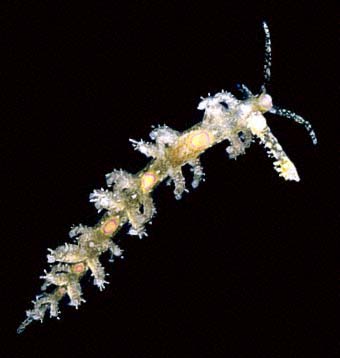
Limenandra nodosa
Haefelfinger & Stamm, 1958
Order: NUDIBRANCHIA
Suborder: AEOLIDINA
Family: Aeolidiidae
PHOTO
Solitary Islands, Coffs Harbour Region, New South Wales, Australia. April 1987, 15mm long. Photos below showing details of colour pattern and ceratal & rhinophore morphology in two different animals. The one in the right photo having much less distinct concentric rings. PHOTOS: Bill Rudman.
This easily recognised aeolid has a circumtropical distribution. It was initially from the Mediterranean, and subsequently from the Caribbean, Gulf of California, and Hawaii. I have also found it in Tanzania, eastern Australia and New Caledonia. There is usually a pattern of concentric rings down the dorsal midline. In its most pronounced form they form a target-like patch of rings: yellow (outer), then red, then white (inner). The colours can be very faint or one or more can be absent. In some specimens only a whitish patch is present. The rings are found on the head, above the heart, and between each cluster of cerata. The cerata are arrange in double rows. Both the cerata and the rhinophores have white papillae. In specimens I have looked at in the Indo-West Pacific, there is a rhythmic simultaneous raising of the large inner cerata as the animal crawls along, making it appear to move in as series of jerks. This unique behaviour does not seem to have been noted from other parts of the world. It has been transferred to the genus Baeolidia by some authors, but Miller's recent review of the family (2001) considers the genus Limenandra should be retained.
Reference:
• Haefelfinger, H.R. & Stamm, R.A. (1958). Limenandra nodosa gen. et spec. nov. (Nudibranch, Aeolidiidae propr.) un opisthobranche nouveau de la Méditerranée. Vie et Milieu, 9(4): 418-423, text figs 1a-d.
• Miller, M.C. (2001) Aeolid nudibranchs (Gastropoda: Opisthobranchia) of the family Aeolidiidae from New Zealand waters. Journal of Natural History, 35: 629-662

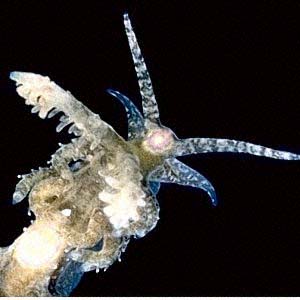
Rudman, W.B., 1999 (April 4) Limenandra nodosa Haefelfinger & Stamm, 1958 . [In] Sea Slug Forum. Australian Museum, Sydney. Available from http://www.seaslugforum.net/find/limenodo
Related messages
Re: Limenandra nodosa from Heron Island
December 2, 2009
From: Hans Bertsch
Concerning message #13532:
Dear Bill and Julie,
I do not know how widely the "cerata pumping" is in Limenandra nodosa, but I described it in some detail when I published the first record of this species from the east Pacific, at Las Cruces, Baja California Sur (24º 13'N; 110º 05' W).
- Bertsch, Hans. 1972. Two additions to the opisthobranch fauna of the southern Gulf of California. The Veliger 15 (2): 103-106.
Cheers,
Hans
hansmarvida@sbcglobal.net
Dear Hans,
Thanks for the reference. It's one of yours that I had overlooked. I first saw this species doing its 'ceratal dance' in Tanzania in the 1970s so I guess we can say it does it from east Africa to the east Pacific. Looking back on earlier messages on the Forum, I seem to have mentioned the 'jerking' [= pumping] in almost every reply. It is so unusual I was surprised others hadn't mentioned it - obviously apart from you.
Best wishes,
Bill Rudman
Re: Limenandra nodosa from Spain
November 27, 2009
From: Juan Lucas Cervera
Concerning message #22861:
Dear John and Bill,
I have to tell that this rare species has been recorded previously from southeastern Iberian peninsula (Spain) and Balearic Islands. So, that John's animal is not the first record of this species from Spain. More details about records of this species from Spain are in the checklist of the opisthobranchs from Spain and Portugal published by Cervera et al (2006).
- J. L. Cervera, G. Calado, C. Gavaia, M. A. E. Malaquias, J. Templado, M. Ballesteros, J. C. García-Gómez & C. Megina. (2006) An annotated and updated checklist of the opisthobranchs (Mollusca: Gastropoda) from Spain and Portugal (including islands and archipelagos). Boletín Instituto Español de Oceanografía 20 (1-4): 1-122
Best.
Lucas.
lucas.cervera@uca.es
Thanks Lucas,
Best wishes,
Bill Rudman
Limenandra nodosa from Spain
November 26, 2009
From: John de Jong
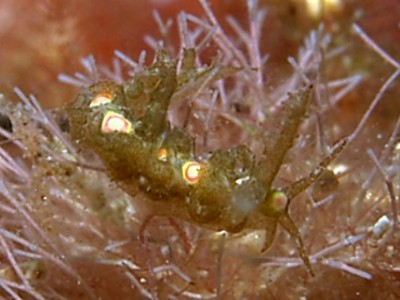
Hi Bill
I spotted this Limenandra nodosa in the summer of 2008 near Rosas, on the Costa Brava of Spain. Because I couldn´t find it in the local guides it took some time to identify it. With help of Dr Lucas Cervera we found that this might be the first time this species has been seen in Spanish waters.
Locality: Rosas, 12 m, Spain, Mediteranranean Sea, 16-07-2008. Length: 2-4 mm. Photographer: John de Jong.
Best regards,
John de Jong
www.jojodive.nl
john@jojodive.nl
de Jong, J., 2009 (Nov 26) Limenandra nodosa from Spain. [Message in] Sea Slug Forum. Australian Museum, Sydney. Available from http://www.seaslugforum.net/find/22861Dear John,
Thanks for this interesting find. Since being described from the Mediterranean in 1958 it has been found in warm waters all around the world. It is probably a 'hitchhiker' species whose original 'home' is probably a mystery. Did you see it 'jerking' its inner cerata up and down as it crawled along? It has a very characteristic movement.
Best wishes,
Bill Rudman
Limenandra nodosa from Heron Island
April 20, 2005
From: Julie Marshall

Dear Bill,
Attached are some photos of Limenandra nodosa found from sieving material from the reef flat at Heron Island at low tide. It was 9 mm in size and, like the other specimens you have observed from the West Pacific region, Bob Burn and I noticed that it moved its large inner cerata backwards and forwards as it crawled along.
Locality: Heron Island, Great Barrier Reef, Queensland, Australia. Pacific Ocean. Depth: Intertidal. Length: 9 mm. 18 March 2005. Intertidal. Photographer: Julie Marshall
Best wishes
Julie Marshall
juliemarshall@netspace.net.au
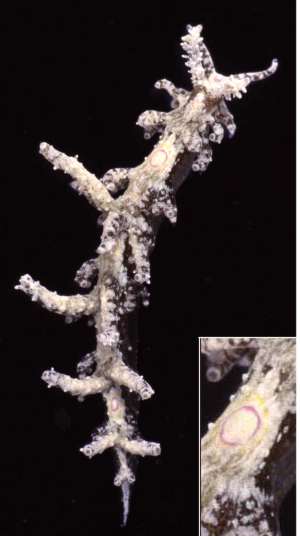
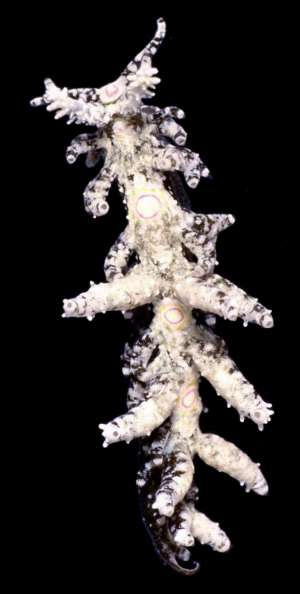
Dear Julie,
Thanks for these photos of Limenandra. It is indeed a very easily identified aeolid with the papillate rhinophores, papillate cerata and the pattern of concentric 'bulls-eye' markings down the back. I am glad you saw the rhythmic waving of the inner cerata as it crawled along
Best wishes,
Bill Rudman
Limenandra nodosa from Jamaica
October 18, 2003
From: Ross W. Gundersen


Dear Bill:
Here is another sea slug from Jamaica. As I said in my first message, all specimens were collected from St. Ann's Bay, Jamaica, West Indies. Most specimens were collected using a light weight dredge and photographed by R. Gundersen.
Here is Limenandra nodosa. Dredged at 5 m depth in Thallassia. Shows characteristic reddish circles.
Best wishes,
Ross
ross.gundersen@uwp.edu
Gundersen, R.W., 2003 (Oct 18) Limenandra nodosa from Jamaica. [Message in] Sea Slug Forum. Australian Museum, Sydney. Available from http://www.seaslugforum.net/find/11124
Thanks Ross,
This easily recognisable species certainly has a worldwide distribution in tropical and subtropical waters
Best wishes
Limenandra nodosa from Caribbean
December 19, 2002
From: Linda Ianniello
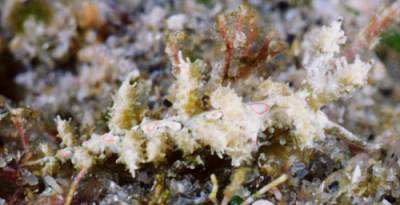
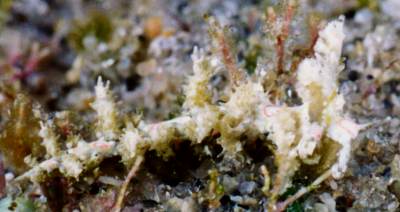
Hi, Dr. Bill,
Here is another unknown from the Caribbean. It was found in a depth of about 12', during the day, in sand and rubble off the coast of Deerfield Beach, Florida. It was very small, about 1/2 inch. I am sorry, the pictures are not very clear and it is tough to see the identifying features except for the red rings down its back, which I hope will be a clue. I can't find anything like it in my Caribbean references. As usual, thanks very much for your help and the forum is an excellent source of information!
Regards,
Linda I.
lindai@us.ibm.com
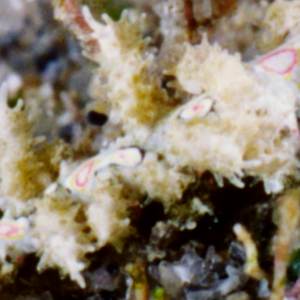
Dear Linda,
The red rings are indeed a distinguishing feature for this species. There are usually a pair of concentric rings, usually red and yellow, and sometimes a central red spot as well. This is Limenandra nodosa, an interesting aeolid with its cerata arranged in double rows. As you will see from my other comments on this page, it has a unique way of 'jerking' its cerata as it crawls along.
Best wishes,
Bill Rudman
Generic placement of Limenandra nodosa
August 9, 2002
From: Alicia Hermosillo
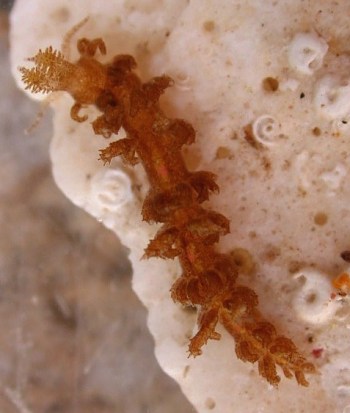
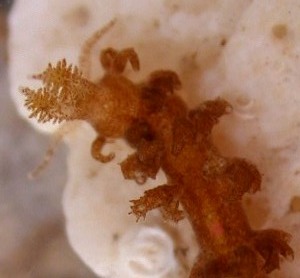
Dear Dr. Rudman,
This species genus has been changed from Limenandra to Baeolidia.
I find this species once in a while in Bahia de Banderas, usually hiding within algae. As you correctly mention, it moves (or better jerks along) pretty much like Aeolidiella alba, and that is basically what gives it away.
Photo: 13mm long, 41 feet deep, Mismaloya, Bahia de Banderas, Pacific Coast of Mexico, April 28th, 2002.
Alicia
gueri25@hotmail.com
Hermosillo, A., 2002 (Aug 9) Generic placement of Limenandra nodosa. [Message in] Sea Slug Forum. Australian Museum, Sydney. Available from http://www.seaslugforum.net/find/7697Thanks Ali,
I'm glad to hear you have found that it 'jerks' along. That means we now have observations of it doing this from both the Caribbean and the east Pacific, to match mine from Tanzania and the western Pacific. I have included a 'close-up' to show the papillae on rthe rhinophores and the cerata.
Concerning its generic placement. Terry Gosliner did indeed place it in Baeolidia but Michael C. Miller's recent review of the family considers the genus Limenandra should be retained, and so I will leave it there. As I have said in a recent message about Aeolidiopsis, this family of aeolids is still causing some problems in our understanding of how the species are related to one another
• Gosliner, T.M. (1985) The aeolid nudibranch family Aeolidiidae (Gastropoda: Opisthobranchia) from tropical southern Africa. Annals of the South African Museum, 95(6): 233-267.
• Miller, M.C. (2001) Aeolid nudibranchs (Gastropoda: Opisthobranchia) of the family Aeolidiidae from New Zealand waters. Journal of Natural History, 35: 629-662.
Best wishes,
Bill Rudman
Re: Limenandra nodosa from Colombia
March 11, 2002
From: Elianny Dominguez Tejo
Dear Bill,
IN answer to your question. We did notice that this species also waved its cerata rhythmically in a jerky backwards and forwards movement.
Best regards,
Elianny.
elicelotte@latinmail.com
Dominguez Tejo,E., 2002 (Mar 11) Re: Limenandra nodosa from Colombia. [Message in] Sea Slug Forum. Australian Museum, Sydney. Available from http://www.seaslugforum.net/find/5531Thanks Elianny,
Bill Rudman.
Limenandra nodosa from Colombia
October 6, 2001
From: Elianny Domínguez Tejo.
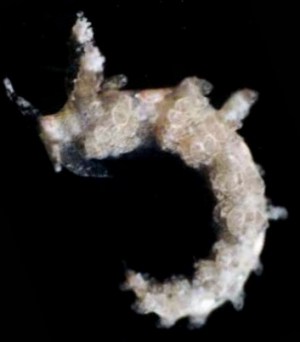

Dear Bill,
Concerning the 'funny nudibranch' you thought might be Limenandra nodosa. Here is another species which we think looks like Limenandra nodosa. We found it on Dictyota sp at 3 m of depth, on the Caribbean Coast of Colombia. It is 6 mm long.
It has 12 circles, 6 of them are complete white and the other 6 are orange whith a white center. The rhinophores have little white buds or papilles? at the end; but the tentacles are complete smooth.
We don't think the 'funny nudibranch' is Limenandra nodosa and have sent separately photos of what we think is Limenandra. It didn't have any kind of circles. The cerates are arranged just like in Austraeolis ornata and Austraeolis catina. The cerata form little crowns (in the dorsal region) with longer cerates towards the head of the animal. The crowns are smaller and with shorter cerates towards the posterior end of the body. The color pattern is also similar to the one on Austraeolis ornata, only lighter. I have more pictures but the one I sent you was the clearer one.
Cheers,
Elianny Domínguez Tejo.
elicelotte@latinmail.com
Domínguez Tejo, E., 2001 (Oct 6) Limenandra nodosa from Colombia. [Message in] Sea Slug Forum. Australian Museum, Sydney. Available from http://www.seaslugforum.net/find/4608Dear Elianny,
From your description I agree that it fits Limenandra nodosa quite well. Did you notice whether this species waved its cerata rhythmically in a jerky backwards and forwards movement?
Best wishes,
Bill Rudman
Limenandra nodosa from Kerama Is
August 19, 1999
From: Atsushi Ono

Dear Bill,
Here is a photo of Limenandra nodosa from Kerama Island [near Okinawa], Japan. I took photographs of several individuals of this species(10-15mm long). Compare this with photos of what I think is another species of Limenandra from Kerama Island.
Sincerely,
Atsushi Ono
ononini@cosmos.ne.jp
Dear Atsushi,
I agree that this really is Limenandra nodosa.
Bill Rudman.
Limenandra? from Sulawesi
April 4, 1999
From: Lindsay Warren

Dear Bill
Please find attached the illustration of another specimen found in the Tukang Besi Islands, SE Sulawesi last year during the research for Operation Wallacea. Sadly it was lost before photos could be taken but fortunately it had been drawn up beforehand!
Length: 5 mm. The rhinophores which were had a pink base with pink tips and heavily speckled white / cream, had distinctive processes sticking out along their length. The body was a translucent pale brown. The foot was translucent with white polka-dots all over it. The base colour of the cerata was red with white spots. The oral tentacles were white spotted and had pink tips. It was found at a depth of 6.4 m in a very small crevice at the top of the reef flat in an outcrop amongst rubble. It was found on a brown sponge. It was said to be similar to Spurilla australis in Willan & Coleman Fig 140.
Any guesses?
All the best,
Lindsay
100014.2112@compuserve.com
Warren, L., 1999 (Apr 4) Limenandra? from Sulawesi. [Message in] Sea Slug Forum. Australian Museum, Sydney. Available from http://www.seaslugforum.net/find/735Dear Lindsay,
I'm pretty sure this is a small specimen of Limenandra nodosa. Its colours don't quite match up, but the papillate rhinophores, cerata in double rows and the basic colour pattern suggest this species.
Best wishes,
Bill Rudman.
